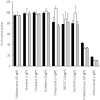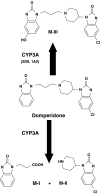Characterization of human cytochrome P450 enzymes catalyzing domperidone N-dealkylation and hydroxylation in vitro
- PMID: 15327587
- PMCID: PMC1884565
- DOI: 10.1111/j.1365-2125.2004.02156.x
Characterization of human cytochrome P450 enzymes catalyzing domperidone N-dealkylation and hydroxylation in vitro
Abstract
Aims: To confirm the identity of the major metabolites of domperidone and to characterize the cytochrome P450s (CYPs) involved in their formation.
Methods: Human liver microsomes (HLMs) were used to characterize the kinetics of domperidone metabolism and liquid chromatography-mass spectrometry to identify the products. Isoform-specific chemical inhibitors, correlation analysis and expressed human CYP genes were used to identify the CYPs involved in domperidone oxidation.
Results: In HLMs, domperidone underwent hydroxylation to form 5-hydroxydomperidone (MIII) and N-dealkylation to form 2,3-dihydro-2-oxo-1H-benzimidazole-1-propionic acid (MI) and 5-chloro-4-piperidinyl-1,3-dihydro-benzimidazol-2-one (MII). The formation of all three metabolites (n = 4 HLMs) followed apparent Michaelis-Menten kinetics. The mean Km values for MI, MII and MIII formation were 12.4, 11.9, and 12.6 micro m, respectively. In a panel of HLMs (n = 10), the rate of domperidone (5 microm and 50 microm) metabolism correlated with the activity of CYP3A (r > 0.94; P < 0.0001). Only ketoconazole (1 microm) (by 87%) and troleandomycin (50 microm) (by 64%) inhibited domperidone (5 microm) metabolism in HLMs. Domperidone (5 and 50 microm) hydroxylation and N-dealkylation was catalyzed by expressed CYP3A4 at a higher rate than the other CYPs. CYP1A2, 2B6, 2C8 and 2D6 also hydroxylated domperidone
Conclusions: CYP3A-catalyzed N-dealkylation and aromatic hydroxylation are the major routes for domperidone metabolism. The drug would be expected to demonstrate highly variable bioavailability due to hepatic, and possibly intestinal first-pass metabolism after oral administration. Increased risk of adverse effects might be anticipated during concomitant administration with CYP3A inhibitors, as well as decreased efficacy with inducers of this enzyme.
Figures



 ), MIII (□)
), MIII (□)
 )
)
 )
)
 ), MII (▪), MI (□)
), MII (▪), MI (□)

Similar articles
-
Identification and characterization of the cytochrome P450 enzymes involved in N-dealkylation of propafenone: molecular base for interaction potential and variable disposition of active metabolites.Mol Pharmacol. 1993 Jan;43(1):120-6. Mol Pharmacol. 1993. PMID: 8423765
-
N-Dealkylation and hydroxylation of ebastine by human liver cytochrome P450.Drug Metab Dispos. 1998 Jun;26(6):566-71. Drug Metab Dispos. 1998. PMID: 9616193
-
Identification of the cytochrome P450 enzymes involved in the metabolism of domperidone.Xenobiotica. 2004 Nov-Dec;34(11-12):1013-23. doi: 10.1080/00498250400015301. Xenobiotica. 2004. PMID: 15801545
-
Linking Aromatic Hydroxy Metabolic Functionalization of Drug Molecules to Structure and Pharmacologic Activity.Molecules. 2018 Aug 23;23(9):2119. doi: 10.3390/molecules23092119. Molecules. 2018. PMID: 30142909 Free PMC article. Review.
-
N-Dealkylation of Amines.Molecules. 2022 May 20;27(10):3293. doi: 10.3390/molecules27103293. Molecules. 2022. PMID: 35630770 Free PMC article. Review.
Cited by
-
Predictive Models for Human Cytochrome P450 3A7 Selective Inhibitors and Substrates.J Chem Inf Model. 2023 Feb 13;63(3):846-855. doi: 10.1021/acs.jcim.2c01516. Epub 2023 Jan 31. J Chem Inf Model. 2023. PMID: 36719788 Free PMC article.
-
Rational prescription of drugs within similar therapeutic or structural class for gastrointestinal disease treatment: drug metabolism and its related interactions.World J Gastroenterol. 2007 Nov 14;13(42):5618-28. doi: 10.3748/wjg.v13.i42.5618. World J Gastroenterol. 2007. PMID: 17948937 Free PMC article. Review.
-
Interaction Between Domperidone and Ketoconazole: Toward Prediction of Consequent QTc Prolongation Using Purely In Vitro Information.CPT Pharmacometrics Syst Pharmacol. 2014 Aug 13;3(8):e130. doi: 10.1038/psp.2014.26. CPT Pharmacometrics Syst Pharmacol. 2014. PMID: 25116274 Free PMC article.
-
Medication adherence and tolerability of Alzheimer's disease medications: study protocol for a randomized controlled trial.Trials. 2013 May 4;14:125. doi: 10.1186/1745-6215-14-125. Trials. 2013. PMID: 23782591 Free PMC article. Clinical Trial.
-
Domperidone treatment for gastroparesis: demographic and pharmacogenetic characterization of clinical efficacy and side-effects.Dig Dis Sci. 2011 Jan;56(1):115-24. doi: 10.1007/s10620-010-1472-2. Epub 2010 Nov 10. Dig Dis Sci. 2011. PMID: 21063774
References
-
- Brogden RN, Carmine AA, Heel RC, Speight TM, Avery GS. Domperidone. A review of its pharmacological activity, pharmacokinetics and therapeutic efficacy in the symptomatic treatment of chronic dyspepsia and as an antiemetic. Drugs. 1982;24:360–400. - PubMed
-
- Prakash A, Wagstaff AJ. Domperidone. A review of its use in diabetic gastropathy. Drugs. 1998;56:429–45. - PubMed
-
- Barone JA. Domperidone: a peripherally acting dopamine2-receptor antagonist. Ann Pharmacother. 1999;33:429–40. - PubMed
-
- Woosley RL, Chen Y, Freiman JP, Gillis RA. Mechanism of the cardiotoxic actions of terfenadine. JAMA. 1993;269:1532–6. - PubMed
-
- Cubeddu LX. QT prolongation and fatal arrhythmias. a review of clinical implications and effects of drugs. Am J Ther. 2003;10:452–7. - PubMed
Publication types
MeSH terms
Substances
Grants and funding
LinkOut - more resources
Full Text Sources
Molecular Biology Databases

